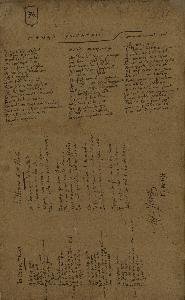Alfred Henri Blaise Jarry
Alfred Henri Blaise Jarry;Alfred Jarry
Place: Laval
Born: 1873
Death: 1907
Biography:
Early Life and Background
Alfred Henri Blaise Jarry, a French symbolist writer, was born in 1873 in Laval, France. His mother's roots hailed from Brittany, which would later influence his work. Jarry's life was marked by an early inclination towards the arts, particularly writing and painting.
Artistic Contributions and Style
Jarry is best known for his play Ubu Roi (1896), a masterpiece that exemplifies his unique blend of hybrid genres and styles. This work not only prefigured postmodernism but also showcased Jarry's versatility in writing novels, poems, short plays, opéras bouffes, absurdist essays, and speculative journalism. Symbolist Movement
Jarry was an integral part of the Symbolist movement, a late 19th-century art movement that sought to represent absolute truths symbolically. This movement emerged as a reaction against naturalism and realism, with Jarry being one of its leading figures. His texts are considered examples of absurdist literature and postmodern philosophy.
Notable Works and Influences
- Ubu Roi (1896), a play that marked the beginning of Jarry's foray into the world of symbolist writing. - The Symbolist Manifesto ("Le Symbolisme"), published in Le Figaro on 18 September 1886, which named Charles Baudelaire, Stéphane Mallarmé, and Paul Verlaine as the leading poets of the movement.
Legacy and Impact
Jarry's influence can be seen in various aspects of art, from literature to visual arts. His concept of 'pataphysics' has been a subject of interest for many scholars. Jarry died in Paris, France, in 1907, leaving behind a legacy that continues to inspire artists and writers.
- Tubism Art Movement, an offshoot influenced by Jarry's work.
- Cubism on Wikipedia, a movement that shares similarities with Jarry's style of representing multiple perspectives.
- Jarry's Profile on Wikioo.org, featuring his notable works and biography.
Museums and Collections Featuring Jarry's Work
Though primarily known for his literary contributions, Jarry's influence can be seen in various art forms. Some of his works are featured in: - The Matisse Museum in Nice, France, which houses an extensive collection of Henri Matisse's works, influenced by the Symbolist movement. - Art Institute of Chicago (Chicago, United States), featuring a wide range of artworks, including those inspired by Jarry's style. Conclusion
Alfred Henri Blaise Jarry's enigmatic figure continues to intrigue art enthusiasts and scholars alike. His contributions to the Symbolist movement and his innovative approach to writing have left an indelible mark on the world of arts.

